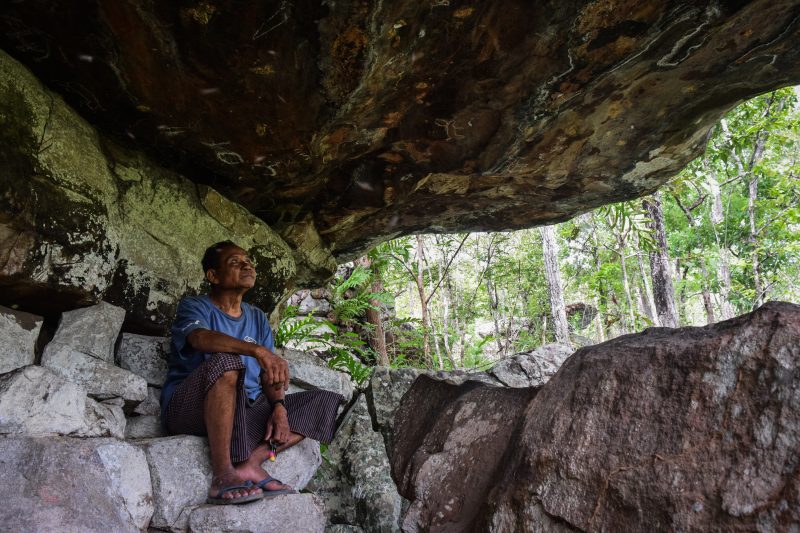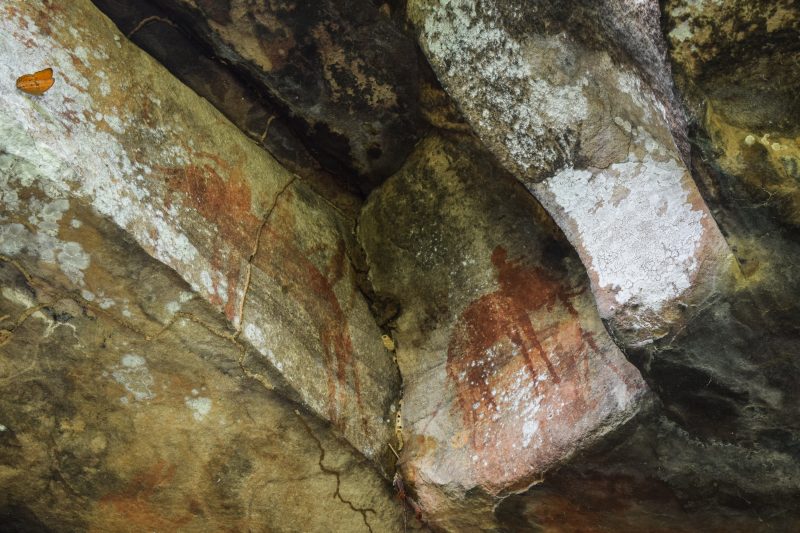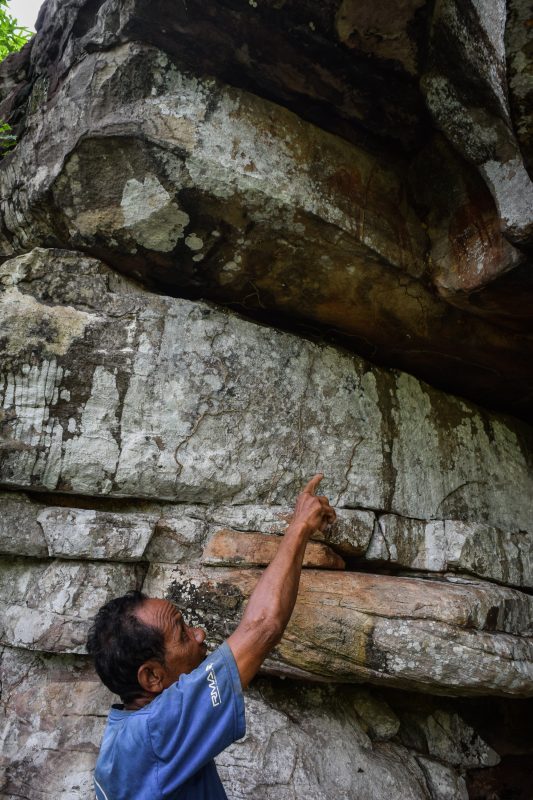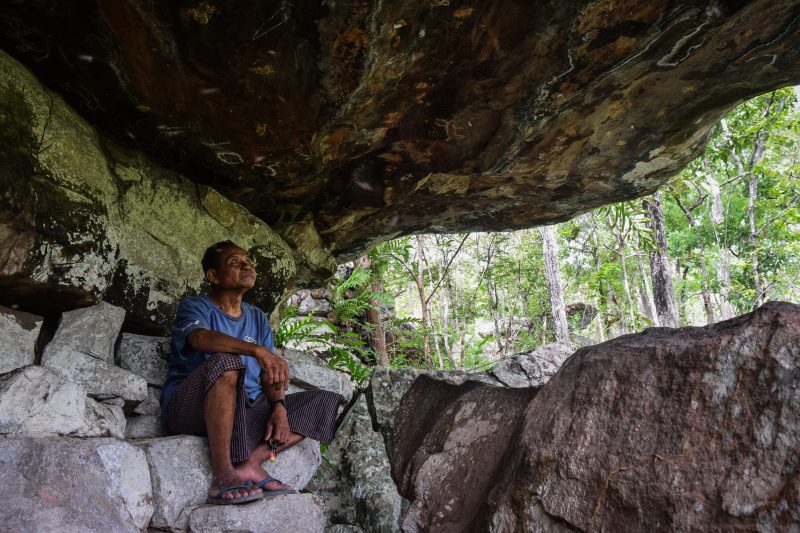Phnom Kravanh district, Pursat province – Take a motorbike 20 minutes north of Veal Veng village, through dense forest and on muddy paths that suck in passing tires, and you come upon a rocky outcrop covered in mysterious ancient paintings.
In the drawings on the roof of the cave, humans ride on the back of elephants among dozens of mostly horned creatures of various shapes and sizes.

As far as anyone knows, the site with 137 red-painted figures is the only one of its kind in the Cardamoms, an isolated mountain range in southwest Cambodia that harbors other relics of an ancient past—burial jars, bones and stupas.
Archaeologists first visited the paintings in 2011, and a team of experts from Cambodia’s Ministry of Culture and the Yusof Ishak Institute in Singapore spent two days at the remote site in Pursat province last year, seeking to determine the age of the art, which villagers revere and visit during Pchum Ben, a holy ceremony that commemorates one’s ancestors.
“The area has been a sacred place for a long time,” 67-year-old villager Chan Choeun said. “During Pchum Ben, many people who can’t travel to a pagoda will go to leave offerings at the rocks.”
The paintings, however, are under siege, threatened by misuse, time and the elements.
No one in Veal Veng knows the provenance of the paintings, said Khvek Dim, the 68-year-old chief of the nearby village of about 30 families, who live in a strip of simple wooden houses.

“They used to be very clear to see,” Mr. Dim said. “But sometime in the last 20 years, children minding cows lit fires to keep warm, and the smoke covered some of the paintings.”
The children also have sketched over the paintings. On the lower and easier to reach sections of the sloped ceiling, lines of white chalk crudely outline the images of the animals.
An academic paper published in May by the team of experts and academics cited a series of threats: spalling, insect nests and trails, plant growth, lichens, moss, salt, wind and water erosion, fading, vandalism and the chalk outlines.
“Due to its rarity, it is very important for regional and global cultural heritage. The preservation condition is fair, but the paintings are not protected,” the report says.
Experts remain unsure of the age of the paintings, but say it is unlikely that they predate the Bronze and Iron Ages, or even the pre-Angkorian Funan Period of the 1st through 5th centuries. And they could be much younger.
“The paintings are probably no older than 2,000-2,500 years,” the paper says. “The lack of anything definitive of the Funan, Chenla, Angkorian, post-Angkorian, Colonial or Modern periods as well as the absence of any Buddhist or Brahmanistic indicators, however, could suggest something earlier than Angkor.”

Communities living in the difficult to access area were well outside the immediate sphere of influence, “possibly due to geographic and cultural remoteness—not uncommon with remote mountainous ethnic groups,” it notes.
A fresh threat to the site is a new dam built about 10 km away. While its construction has made travel to the village more difficult and expensive, it also could lead to a marked rise in the logging of valuable timber, felled before it is covered by floodwaters from the dam.
The village has faced numerous challenges in the past. Once home to more than 600 people, with two villages located even deeper in the forests, the area was roiled in 1974 when hundreds of Khmer Rouge soldiers attacked some 300 villagers, said Mr. Dim, the village chief.
Many men died in the battle, and a large silver elephant carving, which villagers believed was associated with the paintings, was stolen, he said. Later, two large stupas, about 20 meters uphill from the paintings, were also dismantled to provide materials for a smaller dam—now abandoned—and today, two rock piles where they stood resemble little more than cairns.
And though the exact history of the paintings may remain a mystery, the site is home to plenty of stories shared for generations among locals, said Mr. Choeun, the former farmer who now ferries people across the new reservoir.

“There used to be a group of secret people living in the cave, who were friendly and would help villagers with rain in the dry season,” he said, recounting tales told by village elders. “However children from the village came and annoyed them, and the secret people haven’t been seen for a long time.”
Mr. Choeun’s own child, a 24-year-old daughter, Choeun Channa, said the spiritual aspect of the location is still very strong. It also offers a place to sit, relax, and enjoy the paintings, she said, adding that those who did not appreciate the site often met an unfortunate fate.
“A logger once described the paintings as childish, and he instantly got a stomach pain and almost died,” she said. “Another person said that they didn’t believe in the spirits in the area, and they fell down and knocked all of their teeth out.”
While the age and the purpose of the art are unknown, the paper’s authors suggest it might have had an educational focus.
The site “may have been used for preparation, teaching and training as well—the pre-modern equivalent of the PowerPoint presentation,” it says.
Mr. Choeun also suspects that the paintings also had an educational intention. While he can remember elephants and deer frequenting the area 20 years ago, sightings have since become increasingly rare.
“I think that the secret people may have painted them so that our children will be able to see these animals, which used to be so common,” he said. “They are very important for the country.”




